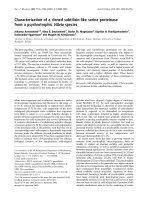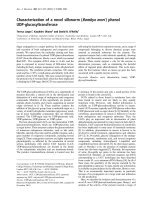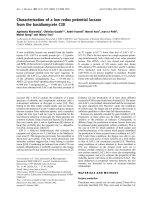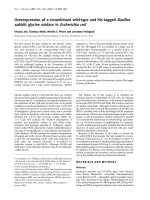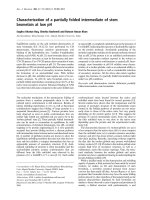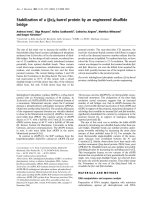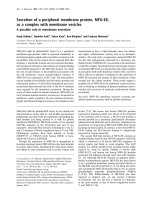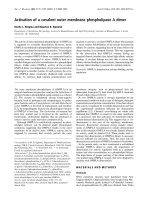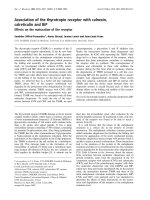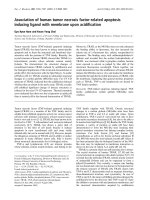Báo cáo y học: "Association of a specific haplotype across the genes MMP1 and MMP3 with radiographic joint destruction in rheumatoid arthritis" ppt
Bạn đang xem bản rút gọn của tài liệu. Xem và tải ngay bản đầy đủ của tài liệu tại đây (154.84 KB, 9 trang )
Introduction
Rheumatoid arthritis is an inflammatory joint disease with
considerable variability. The clinical course ranges from mild
joint swelling to severe polyarthritis with progressive
destruction of cartilage and bone. In recent years, research
has focused on the identification of genes that influence the
susceptibility as well as the severity of this disorder. The
shared epitope (SE), a common peptide sequence on the
antigen-binding regions of some HLA DR4 subtypes and on
HLA DR1, is associated with an increased prevalence and
severity of rheumatoid arthritis (RA) [1,2]. In addition,
promoter polymorphisms of tumor necrosis factor α (TNF-α)
are associated with a more aggressive disease [3].
However, allelic polymorphisms of these genes can only
partly explain the variance of the clinical course, because
the genetic background of RA involves multiple genes [4].
DMARD = disease-modifying antirheumatic drug; ELISA = enzyme-linked immunosorbent assay; IQR = interquartile range; MMP = matrix metallo-
proteinase; OR = odds ratio; PCR = polymerase chain reaction; RA = rheumatoid arthritis; SE = shared epitope of HLA DR4 and DR1; TIMP =
tissue inhibitor of metalloproteinases.
Available online />Research article
Association of a specific haplotype across the genes
MMP1
and
MMP3
with radiographic joint destruction in rheumatoid arthritis
Sylvia Dörr
1
, Nadine Lechtenböhmer
1
, Rolf Rau
2
, Gertraud Herborn
2
, Ulf Wagner
3
,
Bertram Müller-Myhsok
4
, Ingo Hansmann
1
and Gernot Keyszer
5
1
Institute of Human Genetics, University of Halle/Saale, Germany
2
Evangelisches Fachkrankenhaus, Ratingen, Germany
3
Rheumazentrum, University of Leipzig, Leipzig, Germany
4
Bernhard-Nocht-Institute, Hamburg, Germany
5
Department of Internal Medicine I, University of Halle/Saale, Germany
Corresponding author: Gernot Keyszer (e-mail: )
Received: 5 Dec 2003 Revisions requested: 6 Jan 2004 Revisions received: 9 Feb 2004 Accepted: 19 Feb 2004 Published: 8 Mar 2004
Arthritis Res Ther 2004, 6:R199-R207 (DOI 10.1186/ar1164)
© 2004 Dörr et al., licensee BioMed Central Ltd. This is an Open Access article: verbatim copying and redistribution of this article are permitted in
all media for any purpose, provided this notice is preserved along with the article's original URL.
Abstract
The genetic background of rheumatoid arthritis (RA) is only
partly understood, and several genes seem to be involved. The
matrix metalloproteinases MMP1 (interstitial collagenase) and
MMP3 (stromelysin 1) are thought to be important in destruc-
tive joint changes seen in RA. In the present study, functional
relevant promoter polymorphisms of MMP1 and MMP3 were
genotyped in 308 patients and in 110 controls, to test whether
the polymorphisms contribute to the severity of the disease
measured by radiographic progression of joint destruction. For
comparison, the shared epitope of HLA DR4 and DR1 (SE)
was determined by polymerase chain reaction. There was no
association of MMP polymorphisms with susceptibility to RA.
However, a strong linkage disequilibrium was observed
between the 1G/2G (MMP1) and the 5A/6A (MMP3) poly-
morphisms (P << 10
–6
; linkage disequilibrium index D′ = 0.46).
In factorial regression, the degree of radiographic joint
destruction correlated significantly with the 1G-5A haplotype
(P = 0.0001) and the interaction term ‘estimated number of 1G-
5A haplotypes × duration of disease’ (P = 0.0007). This associa-
tion was phasic, indicating that possession of the 1G-5A
haplotype has a protective effect over a period of about 15 years
of RA, but might be associated with a more pronounced radio-
graphic progression later on. Similar results were also found
with the 1G allele of MMP1 alone (P = 0.015) and with the
interaction term ‘estimated number of 1G alleles × duration of
disease’ (P = 0.014). The correlation of SE with the Ratingen
score was comparable (0.044). The regression model of MMP
haplotypes explained 35% of the variance of the radiographic
score, whereas the SE explained 29%. The 1G-5A haplotype
across the closely linked MMP1 and MMP3 gene loci is a
newly described genetic factor strongly associated with the
progression of joint damage in RA. Our findings suggest that
there are haplotypes in a MMP cluster region that modify the
joint destruction in RA in a phasic manner.
Keywords: allelic polymorphism, matrix metalloproteinase, radiographic progression, rheumatoid arthritis
Open Access
R199
R200
Arthritis Research & Therapy Vol 6 No 3 Dörr et al.
The destruction of cartilage and bone in RA is mediated
by proteolytic enzymes secreted by an inflammatory synovial
tissue [5]. Because destructive enzymes of the matrix
metalloproteinase (MMP) family are involved in this process,
allelic polymorphisms of MMP genes could possibly
influence the course of RA.
MMP1 (collagenase) and MMP3 (stromelysin) belong to
the most intensely studied proteases in RA: MMP1 and
MMP3 are secreted on stimulation by inflammatory
cytokines; they degrade key components of cartilage and
bone matrix [6]. MMP1 expression occurs in cells of the
invading front of the activated RA synovial tissue [7] and is
correlated with erosive arthritis [8,9]. Integrated MMP1
levels are correlated with the number of new joint erosions
[10]. Levels of both MMPs are elevated in the serum and
synovial fluid of patients with RA and other inflammatory
joint diseases [10–13]. Serum MMP3 levels are correlated
with markers of inflammation [10] and with the radio-
graphic damage in early RA [9,14,15].
The genes MMP1 and MMP3 are both located at the long
arm of chromosome 11 [16], in a cluster together with five
other MMP genes (MMP7 and MMP10–13). In recent
years, functional relevant polymorphisms of both enzymes
have been detected. The promoter region of MMP1
contains a guanine insertion/deletion polymorphism
(1G/2G polymorphism) at position –1607 [17]. The 2G
allele results in increased transcriptional activity [17]
because the guanine insertion creates a binding site for a
member of the ETS transcription factor family [18]. The
2G allele may contribute to increased invasiveness of
colorectal tumors [19] and to the development of ovarian
cancer [20] and also of lung cancer [21].
The promoter region of MMP3 is characterized by a
5A/6A promoter polymorphism at position –1171 in which
one allele has six adenosines (6A) and the second has five
adenosines (5A) [22]. The 6A allele has a lower promoter
activity than the 5A allele in vitro [23]. This polymorphism
is of influence in conditions involving the deposition of
extracellular matrix such as primary sclerosing cholangitis
[24] and coronary arteriosclerosis [23,25].
In the study presented here, the association of promoter
polymorphisms of both MMP1 and MMP3 on the radio-
graphic progression was investigated in a cohort of 308
patients with RA, considering also the association of the
shared epitope. Because of the location of both MMP
genes on the same chromosome, linkage disequilibrium
was also investigated.
Materials and methods
Patients and controls
The study was approved by the Ethics Committee of the
Medical Faculty of the MLU Halle-Wittenberg. All patients
attended the study after giving written informed consent.
Inclusion criteria were the presence of definite RA as
defined in the American College of Rheumatology criteria
[26], current treatment with disease-modifying antirheumatic
drugs (DMARDs) (see Table 1), continuous treatment by a
single rheumatologist (GH) for at least 4 years and the
presence of at least two sequential radiographs of hands
and feet, for the assessment of the radiographic
progression of joint destruction. A group of 110 unrelated
healthy Caucasian volunteers matched for age and for sex
ratio served as the control group (mean age 50 years, with
79.3% females).
Clinical markers of disease activity
In each patient, 28 peripheral joints were examined for soft
tissue swelling. Erythrocyte sedimentation rate and
C-reactive protein were determined. The modified disease
activity score was calculated as described [27].
Table 1
Characteristics of 308 patients with mild and severe rheumatoid arthritis (RA)
Parameter Mild RA (n = 170) Severe RA (n = 138) All patients
Age (years) 64 (31–88) 65.5 (34–82) 65 (31–88)
Sex (% female) 88.8 79.7 82
Disease duration (years) 12 (4–37) 18.5 (7–44) 14 (4–44)
Ratingen score 9 (0–24) 52 (25–179) 20 (0–179)
Swollen joint count 1 (0–27) 4 (0–28) 2 (0–28)
IgM RF-positive patients 86 (50.5%) 110 (79.7%) 196 (63.6%)
SE-positive patients (%) 55.6 72.4 64.3
CRP (mg/dl) 2 (0.1–94) 3 (0.2–135) 2.0 (0.1–135)
Number of failed DMARDs 1 (0–3) 2 (0–9) 1 (0–9)
Values are given as percentages or as medians (range), with the exception of ‘IgM RF-positive patients’. CRP, C-reactive protein; DMARDs,
disease-modifying antirheumatic drugs; RF, rheumatoid factor; SE, shared epitope of HLA DR4 and DR1.
R201
Radiographic analysis
Radiographic damage of hands and feet was assessed by
the Ratingen score [28], a modification of the Larsen score.
It evaluates 38 joints separately (all proximal inter-
phalangeal and metacarpophalangeal joints, four sites in
the wrists, interphalangeal joints of the great toes, and
metatarsophalangeals 2 to 5). The amount of joint surface
destruction is graded on a 0 to 5 scale for each joint,
providing a maximum score of 190. Each grade represents
20% of joint surface destruction. All radiographs were
scored by one investigator (RR) who was unaware of the
results of the genetic analyses.
At the Rheumaklinik Ratingen, radiographs of both hands
and feet are routinely obtained for all RA patients at
disease onset and every 2 years thereafter, to evaluate
radiographic progression. For our study we chose
sequential radiographs that were at least 4 years apart, to
detect more marked differences in the radiographic course.
Two sequential radiographs were available for evaluation
in all except five patients. In 228 patients, three sequential
radiographs were scored. The first radiograph was obtained
after a median of 1 year, the second after a median of
6 years and the third after a median of 14 years after
disease onset. The total Ratingen score refers to the last
radiograph obtained in each patient. In addition, the
radiographic progression per year was determined for
each patient and for each radiograph by division of the
Ratingen score by the disease duration at the time that the
radiograph was taken.
DNA isolation
Blood samples containing EDTA as anti-coagulant were
obtained from patients and controls. Genomic DNA was
extracted from peripheral blood leukocytes by using the
QIAamp
®
DNA Blood Mini-Kit (Qiagen, Hilden, Germany).
The plasma was collected for determination of the
concentration of MMP1 and MMP3 and stored at –80°C
(see below).
Genotyping
MMP1 and MMP3 promoter polymorphisms were
determined by single-strand conformation polymorphism
analysis. Polymerase chain reaction (PCR) was performed
with forward and reverse oligonucleotide primers that
were labelled with Cy5 fluorescent dyes. The 1G/2G
polymorphism of MMP1 was identified by using the
primers 5′-GTT ATG CCA CTT AGA TGA GG-3′ and 5′-
TTC CTC CCC TTA TGG ATT CC-3′. To screen for the
5A/6A polymorphism of MMP3, the primers 5′-GGT TCT
CCA TTC CTT TGA TG-3′ and 5′-TCC TGG AAT TCA
CAT CAC TG-3′ were used.
The reaction was performed in a total volume of 20 µl
containing 100 ng of genomic DNA, 15 pmol of each
primer, 200 µM dNTPs , 1 × PCR buffer and 0.75 U of Taq
polymerase (Roche Molecular Biochemicals, Mannheim,
Germany). The solution was incubated for 2.5 min at
94°C, followed by 30 PCR cycles, each for 1 min at 94°C,
45 s at 60°C and 90 s at 72°C, with a final extension for
7 min at 72°C.
The PCR products (1 µl) were mixed with 19 µl of forma-
mide loading dye, denatured for 4 min at 85°C, then
cooled directly on ice; 2 µl of this mixture was subjected
to electrophoresis on a non-denaturing polyacrylamide gel.
Differences in the electrophoretic mobility, based on
specific folding effects induced by the sequence variability,
were detected with an automated sequencer (Alf-express;
Pharmacia, Peapack, NJ, USA).
The validity of the method was checked by sequence
analysis. For all possible allelic forms of MMP1 and
MMP3, PCR products were purified from agarose gels
and sequenced in both directions, using the Thermo
Sequenase Dye Terminator Cycle Sequencing Kit
(Amersham Pharmacia Biotech, Freiburg, Germany) and
an ABI Prism 377 DNA Sequencer (Perkin-Elmer).
Determination of shared epitope
The DR4 subtyping was performed in a sample of 104
randomly chosen patients as described previously [29].
Genomic DNA was amplified with primers DR86AMP-GR
(5′-CTGCACTGTGAAGCTCTCAC-3′; codons 86–92)
and DR86AMP-VR (5′-CTGCACTGTGAAGCTCTCCA-
3′; codons 86–92) as 3′ primers and DRB AMP-4 (5′-
GTTTCTTGGAGCAGGTTAAAC-3′; codons 6–13) at the
5′ end. DR4-specific amplification was achieved by 10
cycles of denaturation at 94°C for 60 s and annealing and
extension at 55°C for 60 s, followed by 30 three-tempera-
ture cycles (20 s at 94°C, 20 s at 55°C and 30 s at 72°C).
Differentiation of DR4 alleles was performed in accor-
dance with the XI.IHWC protocol by hybridisation with
sequence-specific oligonucleotide, using non-radioactive
labelling and detection as described [29]. With this
method the DRB1 alleles from *0401 to *0419, except
0415, could be identified. In all cases of DR4
homozygosity, direct sequencing of PCR products was
performed for confirmation.
Measurement of MMP1 and MMP3 concentrations in
patient plasma
The protein concentration was determined in a subgroup
of 120 patients with defined alleles of MMP1 and MMP3.
Patients were selected to obtain equal proportions of
homozygous and heterozygous individuals in each group.
MMP concentrations were measured by enzyme-linked
immunosorbent assay (sandwich ELISA) (BIOTRAK-
ELISA-System; Amersham International, Little Chalfont,
UK) as described previously [13]. The ELISA for MMP3 is
specific for free MMP3, pro-MMP3 and MMP3 bound to
tissue inhibitor of metalloproteinases-1 (TIMP-1). The
Available online />ELISA for MMP1 recognizes human MMP1 and MMP1
bound to TIMP-1, but not MMP1 bound to the non-
specific proteinase inhibitor α
2
-macroglobulin. It cross-
reacts with pro-MMP1 but not with TIMP-1.
Statistical analysis
For statistical analysis, two groups of patients were
formed: one group with mild disease (n = 170) and a
second group with severe disease (n = 138). The
distinction between the two groups was made by the
Ratingen score, which had to exceed 24 after 4 years in
the group with severe disease. The hypothesis that a joint
haplotype across the genes MMP3 and MMP1 shows an
association with severe RA was tested with a likelihood
ratio test, which tested the frequencies of allele differ-
ences and of a given haplotype in severe and mild cases.
Estimation of haplotype frequencies and allele frequencies
was performed with the program ASSOCIAT.EXE (J Ott,
).
Regression analyses were performed with STATISTICA
v 6. The target phenotype (severity of disease as
measured by the Ratingen score) was used as a
quantitative measure (Ratingen score) and analysed by
factorial regression. All P values from regression analyses
were also checked empirically by means of a bootstrap as
well as a permutation procedure.
Calculation of odds ratios (ORs)
The regression analysis suggested an early increase in the
Ratingen score in patients with no 1G-5A haplotype, with
a shoulder at 15 years of RA (see Fig. 1). For further
analysis, radiographs were selected to form two different
samples. One sample contained the radiographs obtained
less than 15 years after disease onset (n = 282; median
9 years; interquartile range [IQR] 4). The latest radiograph
was chosen if more than one radiograph was available per
patient. The other sample contained one radiograph per
patient after 15 or more years after disease onset
(n = 123, median 18 years, IQR 4). In each sample, ORs
were calculated for the MMP polymorphisms and for the SE
to be associated with a Ratingen score above the median.
For comparison between groups, the Mann–Whitney
U-test and the Kruskal–Wallis test were applied.
Comparisons within groups were performed with the
Wilcoxon test. The correlation of plasma concentrations of
MMP1 and MMP3 with the Ratingen score was tested by
Spearman rank correlation.
Results
Radiographic progression
In the patient group as a whole, the median of the total
Ratingen score was 25 (IQR 41), with a median of
radiographic progression per year of 1.73 (IQR 2.39). The
radiographic progression decreased significantly over
time. The yearly progression between disease onset and
the first radiograph (median 3.0) was significantly higher
than the progression between onset of disease and the
second (median 1.8) and third radiograph (median 1.7),
respectively (for all comparisons, P < 0.001).
Allelic distribution and deviation of
MMP1
and
MMP3
alleles from Hardy–Weinberg equilibrium
No deviations from Hardy–Weinberg equilibrium were
found for the MMP1 or MMP3 alleles, respectively. The
allele frequencies of MMP1 and MMP3 were not different
between RA patients and controls (see Table 2).
Allelic association of
MMP1
and
MMP3
A statistically significant association between alleles at the
MMP1 and MMP3 loci was observed in the group of all
patients. Specifically, a combination of 1G (MMP1) and
5A (MMP3) as well as 2G (MMP1) and 6A (MMP3) was
significantly over-represented in comparison with random
expectations (P << 10
–6
). Actually, most haplotypes were
found to be either 1G-5A (36.4%, expected frequency
25.2%) or 2G-6A (35.0%, expected 24.8%), with only
few 1G-6A (12.8%, expected 25.6%) or 2G-5A (15.8%,
expected 24.4%) allelic combinations (see Table 3). The
linkage disequilibrium index D′ was 0.45 in patients and in
controls. As a consequence we also defined a quantitative
variable, ‘estimated number of 1G-5A haplotypes’, to
capture the haplotypic information. This was in
Arthritis Research & Therapy Vol 6 No 3 Dörr et al.
R202
Figure 1
Three-dimensional surface plot showing the main effects for a multiple
regression of total Ratingen score versus duration of disease and
number of 1G(MMP1)-5A(MMP3) haplotypes. The plot was created
by distance-weighted least-squares interpolation. Black lines represent
patients with either none or two 1G-5A haplotypes. The broken line,
representing patients with one haplotype, is an approximation because
it was not possible to determine exactly the number of patients with
one 1G-5A haplotype. The arrow indicates the maximum increase in
the Ratingen score after 15 years of rheumatoid arthritis in patients
with no 1G-5A haplotype (see the text for further explanations). MMP,
matrix metalloproteinase.
consideration of the fact that it was not possible to
determine exactly how many patients had one 1G-5A
haplotype: in only 84% of all patients who had one 1G
(MMP1) and one 5A (MMP3) allele were both alleles
located on the same chromosome.
Regression analysis of MMP polymorphisms
In univariate analyses, the factor that was most strongly
correlated with the Ratingen score was the duration of
disease (P <10
–6
). We therefore included this variable in
the analyses. In factorial regression, a highly significant
positive correlation was detected between the Ratingen
score and ‘estimated number of 1G-5A haplotypes’ per se
(P = 0.0001). In addition, significant correlation was
detected between the Ratingen score and the interaction
term ‘estimated number of 1G-5A haplotypes × duration
of disease’ (P = 0.0007) (Fig. 1).
In total, the regression model was found to explain 35% of
the variance of the Ratingen score.
Similar, but less significant, results were found with the
MMP1 system alone (number of 1G alleles, P = 0.015)
and with the interaction ‘number of 1G alleles × duration
of disease’ (P = 0.014). P values for the MMP3 system
alone were not significant at the 5% level.
Regression analysis of the SE
In factorial regression, there also was a correlation of the
SE with the Ratingen score (P = 0.044). The presence or
absence of the SE explained 29% of the variance of the
Ratingen score, independently of the location at DR4,
indicating an association of the SE with radiological
progression that was comparable to the effect of the
1G-5A haplotype. The direct comparison between
SE-negative and SE-positive patients by non-parametric
testing indicated a higher Ratingen score in the
SE-positive group (P = 0.026). The presence of the SE on
HLA DR4 was not associated with a more pronounced
radiographic progression, compared with the whole group
of SE-positive individuals.
Time-dependent effect of different genotypes on the
Ratingen score
The data in Fig. 1 suggest that the association of the 1G-5A
haplotype with the Ratingen score is phasic. Patients
without this haplotype show the most rapid increase in the
Ratingen score within the first years of disease, reaching a
peak at about 15 years. In contrast, patients with two 1G-
5A haplotypes seem to develop more pronounced
radiographic damage after more than 15 years of RA.
To analyse this phenomenon further, two samples of radio-
graphs were examined separately. Radiographs obtained
after less than 15 years of RA revealed a median Ratingen
score of 18. The ORs to achieve a Ratingen score above
this median are given in Table 4, showing significant
associations of a higher Ratingen score with the SE.
Patients homozygous for the MMP1 2G allele had a
significantly increased risk in comparison with patients with
the 1G-1G genotype. The absence of the 1G-5A
haplotype was also associated with a higher Ratingen
score than in patients with two haplotypes. No increased
risk for higher radiographic damage was seen with
respect to the MMP3 alleles.
Radiographs taken after more than 15 years of RA had a
median Ratingen score of 38. Calculation of ORs confirmed
the association of the SE with a Ratingen score above this
median. Of interest, the presence of the homozygous
MMP1 2G genotype was now associated with a
significantly lower risk for radiographic damage than in the
homozygotes for the 1G allele. In this sample, no significant
ORs were found in association with the 1G-5A haplotypes.
In both samples, ORs of homozygous patients in
comparison with heterozygotes did not reach statistical
significance, with respect to either the MMP alleles or the
1G-5A haplotype.
Regression analysis of clinical and laboratory data
In factorial regression there was a significant correlation
between the Ratingen score and the disease activity score
Available online />R203
Table 2
Allele frequencies (percentages) of the 1G/2G (
MMP1
)
polymorphism and the 5A/6A (
MMP3
) polymorphism
Locus Allele Controls RA total Severe RA Mild RA
MMP1 1G 53.4 50.8 47.8 53.7
2G 46.6 49.2 52.2 46.3
MMP3 5A 46.8 49.6 47.1 51.2
6A 53.2 50.4 52.9 48.8
MMP, matrix metalloproteinase; RA, rheumatoid arthritis.
Table 3
Allelic combinations of the 1G/2G (
MMP1
) polymorphism and
the 5A/6A (
MMP3
) polymorphism
MMP3
Rheumatoid arthritis patients Controls
MMP1 5A/5A 5A/6A 6A/6A 5A/5A 5A/6A 6A/6A
1G/1G 13.2 11.1 2.1 13.4 16.4 0.9
1G/2G 10.0 28.2 10.0 7.3 26.4 15.5
2G/2G 2.1 8.6 14.6 2.7 6.4 10.9
Results are observed frequencies of all rheumatoid arthritis patients
and controls (percentages). MMP, matrix metalloproteinase.
(P = 0.0001), the C-reactive protein level (P = 0.0053)
and the presence of rheumatoid factor (P < 0.0001).
Neither the MMP haplotype nor the SE was correlated
significantly with the disease activity score or the
laboratory parameters.
Plasma concentrations of MMP1 and MMP3 and MMP
polymorphisms
The plasma concentrations of MMP1 and MMP3 were not
significantly different between patient groups with defined
MMP alleles and did not correlate with the Ratingen score
(data not shown).
Discussion
In recent years, analysis of the inheritable factors of RA
has largely focused on components of the immune
system, such as the SE and the cytokine network [1,2,30].
In the cohort investigated here, the association of the SE
with radiographic progression was seen, as it has in
previous investigations [1,2]. A more prominent
radiographic progression in patients who carried the SE
on HLA DR4 could not be detected, in contrast with other
studies [29].
Our data stress the significance of inheritable factors that
affect joint destruction downstream of the inflammatory
cascade. MMP1 and MMP3 are involved in processes of
tissue remodelling, including wound healing and angio-
genesis, but also in cancer invasion and inflammatory joint
destruction [31,32].
Similarly to other recent investigations [33,34], our study
failed to detect any connection of the MMP1 or MMP3
polymorphism with the susceptibility to RA. This is not
surprising, given the widely accepted perception of RA as
a disease that is dependent on, if not initiated by, T cell-
driven antigen-dependent mechanisms, labelling tissue-
destructive processes as a secondary phenomenon.
However, functional relevant allelic polymorphisms of
MMP genes, specifically the MMP1 polymorphism, could
influence the severity of the disease. The 2G allele of
MMP1 is associated with a higher promoter activity in
vitro [17,18], which leads to the production of increased
amounts of MMP1 protein [35].
Our study shows for the first time a significant linkage
disequilibrium between the 1G/2G MMP1 and the 5A/6A
MMP3 polymorphism. This phenomenon can be attributed
to the proximity of the MMP1 and MMP3 genes. Both
genes have been mapped to the long arm of chromosome
11 in the region 11q22.3 [16], with a distance between
them of 37.64 kilobases. The biological function of this
phenomenon is still unknown. However, our observation
illustrates the tight interrelationship of both enzymes.
MMP1 and MMP3 are often coordinately expressed, and
their promoters contain similar regulatory elements, for
example activator protein-1 (AP-1) and ETS [36]. On the
transcriptional level, they are activated by similar factors
such as interleukin-1 [37], whereas plasmin and trypsin
activate the precursors of both proteins [38]. In addition,
MMP1 and MMP3 interact at the protein level. MMP3
activates latent MMP1, enhancing MMP1 activity in vitro
up to 12-fold [39].
Another novel finding of this study is a significant
association of the 1G-5A haplotype with radiographic
damage. The 1G-5A haplotype explained the variability of
the Ratingen score in the same order of magnitude as the
SE. Our data suggest that this association is phasic. The
possession of the 1G-5A haplotype had a protective
effect over a period of about 15 years of RA that faded in
later stages. In fact, the biphasic association of the homo-
zygous MMP1 1G genotype with radiographic progres-
sion in late RA suggests that the 1G-5A haplotype will
even promote radiographic destruction after more than
15 years of disease. However, this assumption could not
be proved with clarity, owing to the small number of late
RA cases with two 1G-5A haplotypes.
The data presented in Table 4 indicate that this time-
dependent association is due mainly to the contribution of
the MMP1 polymorphism. Patients homozygous for the
Arthritis Research & Therapy Vol 6 No 3 Dörr et al.
R204
Table 4
Odds ratio (OR) and 95% confidence interval (CI) for the achievement of a Ratingen score above the median
Sample 1 Sample 2
Parameter OR 95% CI Pn OR 95% CI Pn
No 1G/5A haplotypes vs two haplotypes 2.85 1.08–7.52 0.032 74 0.75 0.23–2.7 n.s. 37
MMP1 2G/2G vs MMP1 1G/1G 2.41 1.20–4.84 0.012 138 0.31 0.11–0.86 0.023 64
MMP3 5A/5A vs MMP3 6A/6A 1.69 0.86–3.32 n.s. 144 1.76 0.66–4.68 n.s. 69
SE-positive vs SE-negative 3.03 1.24–7.39 0.013 104 4.6 1.34–15.8 0.012 54
P values given are asymptotic P values. Sample 1: radiographs taken earlier than 15 years after disease onset. Sample 2: radiographs taken after
more than 15 years of rheumatoid arthritis. MMP, matrix metalloproteinase; SE, shared epitope of HLA DR 4 and DR1.
MMP1 2G allele had an OR of 3.41 for more pronounced
radiographic damage in the first period of RA. In later
years, the OR of 0.31 points to inversion into a significant
protective effect.
Our data contrast with those of other investigations
reporting the lack of association between this poly-
morphism of MMP1 and radiographic progression in a
sample of 103 patients with early RA [33]. However, the
data provided show a tendency towards higher radio-
graphic scores in the groups with either one or two 2G
alleles, in a comparable manner to our data. However, this
was not significant, perhaps because of the smaller
number of patients. In addition, the previous studies of
MMP1 and MMP3 polymorphisms [33,34] had a shorter
observation period.
A link between the 6A promoter polymorphism of MMP3
and radiographic progression has recently been published
[34]. That study included patients with early RA and
observed the radiographic progression over 4 years. Inter-
estingly, our data do not confirm this strong association
between the 6A polymorphism of MMP3 and radiographic
damage as shown in [34]. Our findings suggest that this
association might be an indirect one, caused by the
linkage disequilibrium between MMP1 and MMP3 poly-
morphisms.
There is currently no proven explanation for the phasic
nature of the association between the haplotype and joint
destruction. Radiographic damage is modulated by
genetic factors and by the response to DMARD therapy
alike, but genes can also influence the long-term response
to therapy. In addition, it can be speculated that the
processes of destruction in earlier arthritis are distinct
from those in late RA [40].
Our data stress the relative importances of MMP1 and
MMP3 with respect to joint destruction. This agrees with
another publication that describes the correlation of
integrated MMP1, but not MMP3, levels with the number
of new joint erosions [10]. In addition, the radiological
arrest of patients with successful DMARD treatment is
accompanied by a reduction of MMP1 expression but not
that of MMP3 [41]. In contrast, others have described
baseline MMP3 levels as a predictor for the development
of joint erosions in a longitudinal study [9].
Conclusions
Taken together, our findings suggest that there are
haplotypes in a MMP cluster region that modify the joint
destruction in RA in a phasic manner. In our study, the
association of the 1G-5A haplotype with radiographic
damage was comparable with that of the SE. In addition,
our data indicate that this association is due mainly to the
contribution of MMP1. Interestingly, this association was
biphasic, indicating that the 1G/2G (MMP1) polymorphism
that is correlated with more marked joint destruction in the
first 15 years might be associated with less damage later on.
For further investigation of the variability of the genetic
background with respect to disease outcome, prospective
cohorts are required that have been observed in the long
term and that are large enough to mirror the complex
interrelation between genetic and environmental factors.
Competing interests
None declared.
Author contributions
SD and NL established all experimental methods and
performed the experiments. Both wrote the Materials and
methods section.
RR and GH took care of all patients. They collected
clinical data and all blood samples and radiographs and
scored them by means of the Ratingen score.
UW carried out the HLA typing.
BM-M performed the statistical analysis.
IH supervised all experimental work and validated the
methods.
GK conceived the study, wrote the grant application,
organized the cooperation and wrote the paper except the
Materials and methods section.
Acknowledgements
This study was supported by a grant of the Department of Culture of
Saxony-Anhalt, Germany (3224A/0020M). SD was supported by a
scholarship of the German Kompetenznetzwerk Rheumatologie. We
thank Professor Regine Wittkowski, Charité Berlin, Germany, for
helpful discussions, and Professor Steffen Gay, University of Zürich,
Switzerland, for carefully reviewing the manuscript.
References
1. Mattey DL, Hassell AB, Dawes PT, Cheung NT, Poulton KV,
Thomson W, Hajeer AH, Ollier WE: Independent association of
rheumatoid factor and the HLA-DRB1 shared epitope with
radiographic outcome in rheumatoid arthritis. Arthritis Rheum
2001, 44:1529-1533.
2. Gregersen PK, Silver J, Winchester RJ: The shared epitope
hypothesis. An approach to understanding the molecular
genetics of susceptibility to rheumatoid arthritis. Arthritis
Rheum 1987, 30:1205-1213.
3. Kaijzel EL, van Krugten MV, Brinkman BM, Huizinga TW, van der
Straaten T, Hazes JM, Ziegler-Heitbrock HW, Nedospasov SA,
Breedveld FC, Verweij CL: Functional analysis of a human
tumor necrosis factor alpha (TNF-alpha) promoter polymor-
phism related to joint damage in rheumatoid arthritis. Mol
Med 1998, 4:724-733.
4. Jawaheer D, Gregersen PK: Rheumatoid arthritis. The genetic
components. Rheum Dis Clin North Am 2002, 28:1-15.
5. Gay S, Gay RE, Koopman WJ: Molecular and cellular mecha-
nisms of joint destruction in rheumatoid arthritis: two cellular
mechanisms explain joint destruction? Ann Rheum Dis 1993,
52 Suppl 1:39-47.
Available online />R205
6. MacNaul KL, Chartrain N, Lark M, Tocci MJ, Hutchinson NI: Dis-
coordinate expression of stromelysin, collagenase, and tissue
inhibitor of metalloproteinases-1 in rheumatoid human syn-
ovial fibroblasts. Synergistic effects of interleukin-1 and
tumor necrosis factor-alpha on stromelysin expression. J Biol
Chem 1990, 265:17238-17245.
7. Xue C, Takahashi M, Hasunuma T, Aono H, Yamamoto K, Yoshino
S, Sumida T, Nishioka K: Characterisation of fibroblast-like
cells in pannus lesions of patients with rheumatoid arthritis
sharing properties of fibroblasts and chondrocytes. Ann
Rheum Dis 1997, 56:262-267.
8. Cunnane G, Fitzgerald O, Hummel KM, Youssef PP, Gay RE, Gay
S, Bresnihan B: Synovial tissue protease gene expression and
joint erosions in early rheumatoid arthritis. Arthritis Rheum
2001, 44:1744-1753.
9. Green MJ, Gough AK, Devlin J, Smith J, Astin P, Taylor D, Emery
P: Serum MMP-3 and MMP-1 and progression of joint damage
in early rheumatoid arthritis. Rheumatology (Oxford) 2003, 42:
83-88.
10. Cunnane G, Fitzgerald O, Beeton C, Cawston TE, Bresnihan B:
Early joint erosions and serum levels of matrix metallopro-
teinase 1, matrix metalloproteinase 3, and tissue inhibitor of
metalloproteinases 1 in rheumatoid arthritis. Arthritis Rheum
2001, 44:2263-2274.
11. Case JP, Lafyatis R, Remmers EF, Kumkumian GK, Wilder RL:
Transin/stromelysin expression in rheumatoid synovium. A
transformation-associated metalloproteinase secreted by
phenotypically invasive synoviocytes. Am J Pathol 1989, 135:
1055-1064.
12. Ishiguro N, Ito T, Obata K, Fujimoto N, Iwata H: Determination of
stromelysin-1, 72 and 92 kDa type IV collagenase, tissue
inhibitor of metalloproteinase-1 (TIMP-1), and TIMP-2 in syn-
ovial fluid and serum from patients with rheumatoid arthritis.
J Rheumatol 1996, 23:1599-1604.
13. Keyszer G, Lambiri I, Nagel R, Keysser C, Keysser M, Gromnica-
Ihle E, Franz J, Burmester GR, Jung K: Circulating levels of
matrix-metalloproteinases MMP-3 and MMP-1, tissue inhibitor
of metalloproteinases-1 (TIMP-1) and MMP-1/TIMP-1 complex
in rheumatic disease. Correlation with clinical activity of
rheumatoid arthritis in comparison to other surrogate
markers. J Rheumatol 1999, 26:251-258.
14. Posthumus MD, Limburg PC, Westra J, van Leeuwen MA, van
Rijswijk MH: Serum matrix metalloproteinase 3 in early
rheumatoid arthritis is correlated with disease activity and
radiological progression. J Rheumatol 2000, 27:2761-2768.
15. Posthumus MD, Limburg PC, Westra J, van Leeuwen MA, van
Rijswijk MH: Serum matrix metalloproteinase 3 levels in com-
parison to C-reactive protein in periods with and without pro-
gression of radiological damage in patients with early
rheumatoid arthritis. Clin Exp Rheumatol 2003, 21:465-472.
16. Spurr NK, Gough AC, Gosden J, Rout D, Porteous DJ, van
Heyningen V, Docherty AJ: Restriction fragment length poly-
morphism analysis and assignment of the metalloproteinases
stromelysin and collagenase to the long arm of chromosome
11. Genomics 1988, 2:119-127.
17. Rutter JL, Mitchell TI, Buttice G, Meyers J, Gusella JF, Ozelius LJ,
Brinckerhoff CE: A single nucleotide polymorphism in the
matrix metalloproteinase-1 promoter creates an Ets binding
site and augments transcription. Cancer Res 1998, 58:5321-
5325.
18. Tower GB, Coon CC, Benbow U, Vincenti MP, Brinckerhoff CE:
Erk 1/2 differentially regulates the expression from the 1G/
2G single nucleotide polymorphism in the MMP-1 promoter in
melanoma cells. Biochim Biophys Acta 2002, 1586:265-274.
19. Ghilardi G, Biondi ML, Mangoni J, Leviti S, DeMonti M, Guag-
nellini E, Scorza R: Matrix metalloproteinase-1 promoter poly-
morphism 1G/2G is correlated with colorectal cancer
invasiveness. Clin Cancer Res 2001, 7:2344-2346.
20. Kanamori Y, Matsushima M, Minaguchi T, Kobayashi K, Sagae S,
Kudo R, Terakawa N, Nakamura Y: Correlation between expres-
sion of the matrix metalloproteinase-1 gene in ovarian
cancers and an insertion/deletion polymorphism in its pro-
moter region. Cancer Res 1999, 59:4225-4227.
21. Zhu Y, Spitz MR, Lei L, Mills GB, Wu X: A single nucleotide
polymorphism in the matrix metalloproteinase-1 promoter
enhances lung cancer susceptibility. Cancer Res 2001, 61:
7825-7829.
22. Ye S, Watts GF, Mandalia S, Humphries SE, Henney AM:
Preliminary report: genetic variation in the human stromelysin
promoter is associated with progression of coronary athero-
sclerosis. Br Heart J 1995, 73:209-215.
23. Ye S, Eriksson P, Hamsten A, Kurkinen M, Humphries SE, Henney
AM: Progression of coronary atherosclerosis is associated
with a common genetic variant of the human stromelysin-1
promoter which results in reduced gene expression. J Biol
Chem 1996, 271:13055-13060.
24. Satsangi J, Chapman RW, Haldar N, Donaldson P, Mitchell S,
Simmons J, Norris S, Marshall SE, Bell JI, Jewell DP, Welsh KI: A
functional polymorphism of the stromelysin gene (MMP-3)
influences susceptibility to primary sclerosing cholangitis.
Gastroenterology 2001, 121:124-130.
25. Terashima M, Akita H, Kanazawa K, Inoue N, Yamada S, Ito K,
Matsuda Y, Takai E, Iwai C, Kurogane H, Yoshida Y, Yokoyama M:
Stromelysin promoter 5A/6A polymorphism is associated with
acute myocardial infarction. Circulation 1999, 99:2717-2719.
26. Arnett FC, Edworthy SM, Bloch DA: The American Rheumatism
Association 1987 revised criteria for the classification of
rheumatoid arthritis. Arthritis Rheum 1988, 31:315-324.
27. Prevoo ML, ’t Hof MA, Kuper HH, van Leeuwen MA, van de Putte
LB, van Riel PL: Modified disease activity scores that include
twenty-eight-joint counts. Development and validation in a
prospective longitudinal study of patients with rheumatoid
arthritis. Arthritis Rheum 1995, 38:44-48.
28. Rau R, Wassenberg S, Herborn G, Stucki G, Gebler A: A new
method of scoring radiographic change in rheumatoid arthri-
tis. J Rheumatol 1998, 25:2094-2107.
29. Wagner U, Kaltenhauser S, Sauer H, Arnold S, Seidel W,
Hantzschel H, Kalden JR, Wassmuth R: HLA markers and pre-
diction of clinical course and outcome in rheumatoid arthritis.
Arthritis Rheum 1997, 40:341-351.
30. Cantagrel A, Navaux F, Loubet-Lescoulie P, Nourhashemi F,
Enault G, Abbal M, Constantin A, Laroche M, Mazieres B: Inter-
leukin-1beta, interleukin-1 receptor antagonist, interleukin-4,
and interleukin-10 gene polymorphisms: relationship to
occurrence and severity of rheumatoid arthritis. Arthritis
Rheum 1999, 42:1093-1100.
31. John A, Tuszynski G: The role of matrix metalloproteinases in
tumor angiogenesis and tumor metastasis. Pathol Oncol Res
2001, 7:14-23.
32. Ye S: Polymorphism in matrix metalloproteinase gene pro-
moters: implication in regulation of gene expression and sus-
ceptibility of various diseases. Matrix Biol 2000, 19:623-629.
33. Constantin A, Lauwers-Cances V, Navaux F, Abbal M, van Meer-
wijk J, Mazieres B, Cambon-Thomsen A, Cantagrel A: Collage-
nase-1 (MMP-1) and HLA-DRB1 gene polymorphisms in
rheumatoid arthritis: a prospective longitudinal study. J
Rheumatol 2002, 29:15-20.
34. Constantin A, Lauwers-Cances V, Navaux F, Abbal M, van Meer-
wijk J, Mazieres B, Cambon-Thomsen A, Cantagrel A:
Stromelysin 1 (matrix metalloproteinase 3) and HLA-DRB1
gene polymorphisms: association with severity and progres-
sion of rheumatoid arthritis in a prospective study. Arthritis
Rheum 2002, 46:1754-1762.
35. Fujimoto T, Parry S, Urbanek M, Sammel M, Macones G, Kuiv-
aniemi H, Romero R, Strauss JF III: A single nucleotide polymor-
phism in the matrix metalloproteinase-1 (MMP-1) promoter
influences amnion cell MMP-1 expression and risk for
preterm premature rupture of the fetal membranes. J Biol
Chem 2002, 277:6296-6302.
36. White LA, Maute C, Brinckerhoff CE: ETS sites in the promoters
of the matrix metalloproteinases collagenase (MMP-1) and
stromelysin (MMP-3) are auxiliary elements that regulate
basal and phorbol-induced transcription. Connect Tissue Res
1997, 36:321-335.
37. Hui A, Min WX, Tang J, Cruz TF: Inhibition of activator protein 1
activity by paclitaxel suppresses interleukin-1-induced colla-
genase and stromelysin expression by bovine chondrocytes.
Arthritis Rheum 1998, 41:869-876.
38. Rao CN, Mohanam S, Puppala A, Rao JS: Regulation of
ProMMP-1 and ProMMP-3 activation by tissue factor pathway
inhibitor-2/matrix-associated serine protease inhibitor.
Biochem Biophys Res Commun 1999, 255:94-98.
39. Murphy G, Cockett MI, Stephens PE, Smith BJ, Docherty AJ:
Stromelysin is an activator of procollagenase. A study with
Arthritis Research & Therapy Vol 6 No 3 Dörr et al.
R206
natural and recombinant enzymes. Biochem J 1987, 248:265-
268.
40. Firestein GS, Zvaifler NJ: How important are T cells in chronic
rheumatoid synovitis? II. T cell-independent mechanisms
from beginning to end. Arthritis Rheum 2002, 46:298-308.
41. Katrib A, Smith MD, Ahern MJ, Slavotinek J, Stafford L, Cuello C,
Bertouch JV, McNeil HP, Youssef PP: Reduced chemokine and
matrix metalloproteinase expression in patients with rheuma-
toid arthritis achieving remission. J Rheumatol 2003, 30:10-21.
Correspondence
Gernot Keyszer MD, Martin Luther-Universität Halle-Wittenberg
(MLU), Medizinische Fakultät, Klinik und Poliklinik für Innere
Medizin I, Ernst-Grube-Strasse 40, 06097 Halle/Saale, Germany.
Tel: +49 345 557 2665; fax: +49 345 557 4934; e-mail:
Available online />R207
